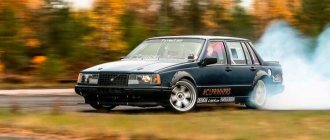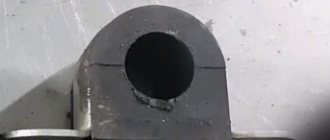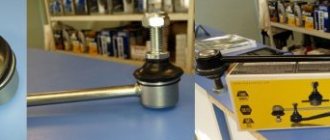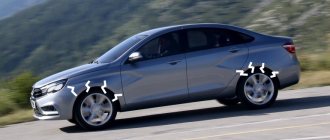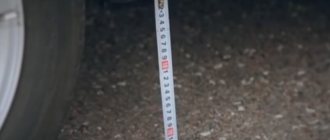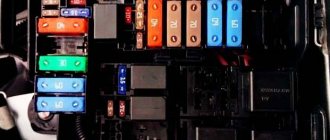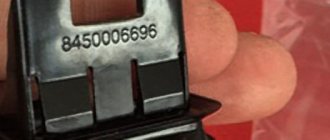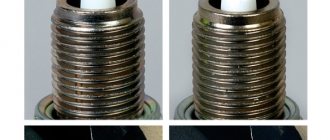Even at the stages of car development, it was known that the Vesta platform would be truly new, and not just another modernization of the VAZ 2108 suspension. Now that serial production of the sedan has already started, and the first samples have already been on test drives in various car magazines, more detailed details are being clarified about the chassis of the Lada Vesta.
The last adjustments to the suspension characteristics took place in winter in Spain, at the IDIADA training ground. Then a balance was found between comfort and car controllability. What happened?
Lada Vesta front suspension design
The supporting structure is based on a subframe, which is an innovation for the domestic automobile industry. Also, for the first time, the L-shaped levers were used.
The subframe performs the additional function of strengthening the body, giving it strength, and preventing deformation on uneven surfaces. As a result, the overall safety score was increased by five points.
In general, the suspension design is quite simple and in many ways similar to Renault Logan and Renault Duster of the second generation. Carrying out preventive maintenance does not require additional costs. The steering gear is now secured to the bottom of the engine compartment.
Independent suspension
From a physical point of view, the “low” position of the rack provides maximum connection with the steering knuckle. An electric amplifier is pre-installed on the rail, which was not previously in the design of VAZs. The shape of the transverse stabilizer has been redesigned to improve the “feel” when turning the steering wheel. The castor (tilt) angle is 5°, independent suspension, MacPherson struts, which together make the car smoother.
What ball joints to install on Lada Vesta
The choice of balls for Vesta is not particularly impressive yet. There are several well-known companies, and there are several new ones that are not yet particularly trusted. However, the factory supports have catalog numbers 8450006741 left and 8450006742 right. At the same time, you will have to pay around $12 apiece for a native part. There are a number of analogues:
- Fenox, BJ11021/BJ12021 (right/left), Belarus, price $6.5, quality below average;
- Pilenga, article number TSP3177, price $3, no reviews;
- Kroner, K330119/K330119, price $3.2 each;
- TRT, RS8026RL, Türkiye, pair, price $10;
- AT, AT6741845BJ/AT6741945BJ, price $5 each;
- BelMag, LH/RH, price $6 each.
Structurally, the ball joint and the lever are one-piece, that is, they must be changed together. Of course, there is a certain amount of logic in this. The manufacturer calculated that by the time the support dies, the silent blocks of the lower arm will also die. In this case, you can buy a lever with a ball assembly. Its article number is 8450006743, and it costs about $18. If everything is in order with the silent blocks of the lever, then it is cheaper to replace the support separately.
Rear suspension device
The food is borrowed from the French brand Renault Logan of the second generation. The design is typical - a transverse metal beam with springs spaced on the sides.
The brake system is of a drum type, which was expected, since disc mechanisms would increase the cost of the model by 3 - 4%. In general, the “drums” do an excellent job of the task at low and medium speeds.
Design (diagram):
- Levers.
- Gaskets for springs.
- Upper support.
- Compression buffer.
- Gas shock absorber.
- Hub axis.
- Brake drum.
- The wheelbase is extended to 1510 mm.
Crash test of Lada Vesta and comparison with competitors
ENCAP Safety Rating
Kia Rio - 5 stars:
- driver and passenger safety - 92%;
- safety of child passengers - 84%;
- reliability of pedestrian protection - 46%;
- security systems - 86%.
Renault Logan - 3 stars:
- driver and passenger safety - 57%;
- safety of child passengers - 75%;
- reliability of pedestrian protection - 55%;
- security systems -38%.
Skoda Rapid - 5 stars:
- driver and passenger safety - 94%;
- safety of child passengers - 75%;
- reliability of pedestrian protection - 69%;
- security systems -71%.
Volkswagen Polo - 5 stars:
- driver and passenger safety - 97%;
- safety of child passengers - 85%;
- reliability of pedestrian protection - 76%;
- security systems -71%.
Hyundai Solaris has not been tested under the Euro NCAP system. ARCAP tests gave a score of 8.5, which corresponds to three stars.
The LADA Vesta has not been tested under the Euro NCAP system. ARCAP testing yielded a score of 14.1, which equates to four stars.
Until recently, it was hard to believe that AvtoVAZ would release a new Lada model that would satisfy the needs of car enthusiasts. 3 years after the first Vesta rolled off the assembly line, we can say that he succeeded.
What do you choose? Poll Options are limited because JavaScript is disabled in your browser.
What's new: about built-in technologies and stabilization system
In addition to the above innovations, we additionally note the presence of systems:
- ABS;
- ESP;
- EBD;
- electric power steering wheel from the Japanese concern Nissan;
- braking system from French Renault.
The stabilization system controls the vehicle's traction, which makes it easy to overcome various drifts and obstacles while driving.
You can significantly improve the vehicle's maneuverability by simulating a differential lock. In Lada Vesta such a system is configured very effectively. Now the car is not “afraid” of dirt, bumps, or wet roadsides. When the mode is activated, the electronics enter the “all-terrain” phase. It is not recommended to use this mode on an ongoing basis.
About Vesta suspension malfunctions
Despite the significant modernization of the chassis in the Lada Vesta, such an element as the front suspension or rear suspension can upset owners with various breakdowns. The appearance of a malfunction traditionally begins to be accompanied by knocking and squeaking noises when the car overcomes uneven road surfaces. Here, the owner requires maximum attention necessary to promptly identify a breakdown and then eliminate it.
Next, we will consider the most common faults that have become typical for the front and rear suspensions of the LADA Vesta.
Shock absorber struts quite often “respond” with knocks. You can check the shock absorbers yourself. This should be done with the car just stopped, when the fluid inside the strut housings is at operating temperature. To do this, you will need to rock one of the sides of the car and observe the behavior of the body. The operation is performed first on the front and then on the rear axle. If the body oscillates in the vertical plane no more than two times, then the strut is in good condition. When this is not observed, it is recommended to replace the shock absorber.
Advice! When diagnosing the suspension, you should adhere to generally known safety rules.
For a more detailed check of the chassis, you will need to hang the wheel from one side of the car. The following shortcomings may be identified here.
- If the brake pedal is not pressed and there is noticeable play when manually pressing the wheel, this indicates a faulty wheel bearing.
- When play is heard when acting on the levers or steering tips, then most likely the ball joints of these suspension elements have become unusable, which also requires their replacement.
- We subject the shock-absorbing struts to a detailed inspection of the working surface to ensure there are no fluid leaks. When it appears, it is recommended to replace the racks (two).
- We also inspect the fastening elements of the stabilizer (struts and bushings) for tears in the rubber components and anthers.
- Noises and squeaks from the front can be caused by a lack of sufficient lubrication in the support bearings of the struts.
- In the stern suspension, noise effects can sometimes be eliminated by installing washers under the racks. After such manipulation, a gap appears between the pillar and the body support, which must be isolated in order to prevent moisture and dirt from penetrating there.
- In some cases, the muffler may make knocking noises. Here the “culprits” are the fastening components, which also need to be lubricated or replaced.
- The LADA Vesta wheel bearing may also begin to make noise and show play. This is caused by the absence or insufficient amount of lubricant. Since the bearing cage is structurally closed, it will not be possible to replenish the lubricant. Although the manufacturer guarantees the effectiveness of the lubricant for the entire scheduled service life of the product, in reality the situation may be completely different. If the presence of these defects is detected, the bearing must be replaced. You can do it yourself if the owner has a special tool (press, pullers, etc.) and has experience.
Important! If the car is supported by a jack, then during repair procedures it is necessary to place suitable supports under the body for safety reasons.
- The lower shock absorber bushings in the rear suspension (pictured) are also capable of making knocking noises when they become critically worn.
- Driving along country roads is fraught with the risk of debris (stones) getting inside the brake drum, which provokes an unpleasant sound effect. Over time, these “artifacts” fall out on their own, but there are often cases when dismantling the drum is required to remove them.
Important! If the front suspension's levers and steering ends (also rods) were replaced, then after the repair work it is necessary to immediately adjust the wheel angles. If this procedure is neglected, the front tire treads will be subject to uneven wear and handling will deteriorate significantly.
Attention! An element such as a handbrake cable can cause knocking noises in the LADA Vesta suspension. Here you will need to inspect its placement under the bottom and, if sagging areas are observed, take measures to tie them up.
What are the advantages of the new Lada Vesta suspension?
- The suspension concept has been radically changed. The supporting structure is based on a subframe at the bottom of the engine compartment;
- increased rigidity;
- compliance of body geometry with standards;
- improvement of vibro-acoustic properties;
- steering rods are directly connected to the hubs;
- castor (tilt) angle is 5°;
- MacPherson struts;
- upgraded anti-roll bar;
- maximum adaptation for domestic roads.
Conclusion
The average resource of the front and rear suspension of a car is designed for 90,000 km and above. If you follow the manufacturer's recommendations, take care of the equipment, and moderate speed conditions, the replacement interval for parts can be increased to 120 - 130 thousand km.
Carry out preventive work at certified service stations, where they provide a guarantee. If you have experience, practice repairs yourself, but this should not conflict with the requirements of the warranty. Buy spare parts mainly from domestic manufacturers. The quality of the components is not inferior to foreign analogues, and the price is 25–30% cheaper.
Wear of stabilizer link joints
If, when driving over a speed bump, a dull knock or squeak is heard from the front, there is a high probability that the reason for this is premature wear, due to the poor quality of the material, of the standard anti-roll bar bushings of the Lada Vesta - a malfunction typical of the VAZ sedan. In this case, other signs corresponding to the assumption should be present:
- knocking of the chassis when the car rolls while moving;
- beating in the steering wheel when driving on a flat surface at speeds above 60 km/h;
- increased play in the steering mechanism during intensive maneuvering;
- involuntary deviation of the car from straight-line movement.
When diagnosing stabilizer bushings, as a rule, all elements of the front suspension are inspected and, first of all, the vertical struts of the anti-roll bar (article no. 8450006750), which also often fail in Lada Vesta.
Lada Vesta produces standard stabilizer bars. These parts are of fairly high quality, but they also have their own resource, which depends on many factors. The degree of wear of the vertical struts is determined by the presence of play in their hinges - if the struts knock when the stabilizer is suddenly manually moved, they need to be replaced. Knowing the length of the struts (283 mm), you can select even better parts for replacement, for example, from Toyota or Hyundai.
- socket wrench “16” - unscrewing the nut;
- Torx key 30 – pin locking.
In any car, even the most advanced, design flaws appear over time. You can eliminate them yourself or in service centers, but first you need to accurately localize the source.
The stabilizer bushings of the Lada Vesta model often become a reason for dissatisfaction among owners after a relatively short period of time.
The tips in this material will help you deal with the problem.
Almost without exception, owners of Lada Vesta and Vesta SV Cross cars immediately after purchasing the car begin to notice a characteristic creaking of the suspension in the front part.
After searching for the sources of the squeak, it turns out that the culprit is the stabilizer bar rubber. Or rather, the material from which they are made is to blame.
Most likely, this is a design miscalculation or another attempt by AvtoVAZ to save money.
Today we will look at issues related to problems with the elements of the front stabilizer bar of the Lada Vesta suspension. Replacing the bushings with your own hands is quite possible. We will also tell you which bushings are suitable for this car.
1 years ago
2 weeks ago
2 years ago
Many owners of the Lada Vesta sedan experience creaking in the suspension. If a squeak appears in the front of the car after overcoming uneven roads, then most likely the source of extraneous noise is the anti-roll bar cushions (bushings). Let's figure out how to replace them with your own hands.
The condition of the anti-roll bar cushions is checked visually; there should be no bulging or cracking of the rubber. If you can’t get rid of squeaks by lubricating the bushings, try using other, higher-quality stabilizer pads, for example, polyurethane ones from Niva Chevrolet (article number: 17012680).
Attention! The stabilizer pads should be replaced only when the stabilizer is in a relaxed state (both front wheels are suspended or evenly loaded with the weight of the vehicle)
Drive Vesta onto a pit or overpass; Clean the bolts securing the stabilizer bar from the bottom of the car; Completely unscrew one bolt securing the stabilizer bar mounting bracket. We unscrew the second fastening bolt, which is closer to the steering rack, as far as possible (Torx T40 wrench); Move the bracket to the side and remove the stabilizer bushing. Turn the anthers themselves together with the clamps; Turn the airbag mounting clamp in a circle; Remove the steering rack protection, then loosen the steering rack mounting bolts and lift it up. Or remove the steering rack completely.
Reviews
| № | Positive |
| 1. | Dmitry Vasilyevich , 43 years old (otzovik.com): the suspension is mounted on a subframe, a new form of levers, steering knuckles. Road obstacles are overcome without impact. |
| 2. | Arkady Semenovich , 39 years old (www.zr.ru): there are no complaints about the suspension at speeds up to 120 – 130 km/h, it works quickly and softly. At higher modes, there is a decrease in control efficiency, the car rolls when entering turns. |
| 3. | Kirill , 22 years old (autobann.su): control is sharp due to the fact that the rack is pre-installed on the subframe and has an indirect connection with the steering knuckles. |
| 4. | Matvey , 33 years old (lada-vesta.net): on previous modifications of the Lada, the chassis, suspension, and steering mechanism were worse. I can compare, since before the Lada Vesta there was a Priora and a Granta. |
| 5. | Vasily Petrovich , 43 years old (otzovik.com): my positive review of the chassis and suspension of the Lada Vesta. I've been using the car for three years now, no complaints. |
| 6. | Pyotr Semenovich , 45 years old (www.zr.ru): for me, as a resident of a rural area, you can’t find a better car. I'm happy with the purchase, no complaints. I fix minor breakdowns on my own without going to a service station. |
| 7. | Sergey , 20 years old (autobann.su): rear springs and shock absorbers have become softer compared to the Lada Granta. Minor unevenness is silently absorbed. For our imperfect roads, this is what we need. |
| 8. | Saveliy Petrovich , 43 years old (lada-vesta.net): the vehicle’s ground clearance allows it to overcome many obstacles without reducing speed, detours, or maneuvers. This is very good for city roads when the car follows the flow. |
| 9. | Dmitry , 30 years old (otzovik.com): my positive review of the Lada Vesta, there are no critical comments, and I fix minor breakdowns on my own. |
| 10. | Nikolai Petrovich , 43 years old (www.zr.ru): there are no comments on the components, I systematically carry out technical inspections, diagnostics, and treat equipment with care. The car is three years old, the condition of a new car. |
| 11. | Alexey , 35 years old (autobann.su): replaced the bushings in two years, checked the wheel alignment. I'm pleased with the build quality, my recommendations to motorists. |
| Negative | |
| 12. | Vitaly Nikolaevich , 43 years old (www.zr.ru): in the first year of service, replaced the chassis bushings. The shock absorbers began to leak and the springs began to creak. |
| 13. | Leonid , 27 years old (otzovik.com): after 35,000 km, replaced the standard stabilizer seals with polyurethane ones. The manufacturer saves on materials and installs the cheapest ones. |
| 14. | Arsen Mikhailovich , 45 years old (autobann.su): the model needs to be improved and defects eliminated. It’s better to wait a while or buy a second generation Renault Logan. |
Detected malfunctions in the suspension
Even during the release of the first batches of Vesta from the assembly line, buyers rightly noticed shortcomings in its work, which were corrected in subsequent batches. The sounds that the rear or front suspension can make are very varied - the design is very complex, consisting of many parts that can fail. However, the most common breakdowns among Lada Vesta owners stand out and are worth disassembling.
Creaking, crunching, knocking from the rear suspension of the Lada Vesta
Rear crunching is a fairly old problem for West. The knock of the rear chassis is corrected according to a special instruction from AvtoVAZ, according to which the design will have to be slightly supplemented. Between the upper support and the rear shock absorber strut you need to place a washer with a length of 130 mm, a distance between the holes of 100 mm (hole radii - 5 mm), a base radius of 34 mm, and finally a radius of the main hole of 25 mm.
The crunch will disappear, but only if the washer matches the dimensions, otherwise a gap will appear between the body and the support, into which dirt gets trapped. The cause of concern due to crunching or knocking may also be:
- worn trunk lid damper;
- stretched handbrake cable (it can be pulled from the passenger compartment);
- trunk lock;
- rear sofa backrest fasteners.
And just in case, check the contents of the trunk itself - there may just be tools rattling around there.
Bumping knocks and noises in the front suspension of Lada Vesta
- The first, most popular reason for calling for service is the thumping (knocking) sound of the front suspension of the Lada Vesta, which comes from the stabilizer. Typically occurs when driving over artificial bumps. Stabilizer bushings, unfortunately, are not suitable for long-term use; even lubricant will not help - the only way to treat them is by replacing them. To solve the problem, you can install polyurethane bushings from Niva Chevrolet, its number is 17-012-680.
- The second reason for knocking can be called play of the ball joint, when a large gap is created between the parts. Problems can be solved by changing the design with levers. A grinding noise can be heard due to wear on the stabilizer struts and can mean that the car is gradually “losing” confidence when cornering.
- The creaking of the front suspension is caused by the hinges of the stabilizer struts. While driving, a knocking noise may occur due to insufficient tightening of the wheel bolts. When such a sound is heard, it is better to contact a service station as quickly as possible to prevent parts from breaking.
- The reason why the suspension on the Lada Vesta rattles and creaks can be heard may be that one of the parts has worn down to a sufficient level and is now knocking against another. To notice damage in time, it is enough to periodically inspect your car. If something is rattling, the part can be identified by shaking the car.
- If crunching or knocking noises in the front suspension are heard infrequently, the cause most likely may be a torn steering rod oil seal. This oil seal is in very close contact with the subframe of the vehicle (the distance between them at rest is 1 cm), and they collide at every bump. The oil seal breaks, and the connection of the rod to the rack hits the subframe.
Some difficulties
The semi-independent rear suspension has many advantages. But there is one drawback that Lada Vesta car owners highlight. Its essence lies in the appearance of noise during active use.
In order to establish the true condition of the car, experienced drivers conduct independent diagnostics. Before testing, vehicles are positioned so that the front wheels do not contact the surface. When the wheels move, play is established.
Other procedures are also performed. It is important that the car is parked on an overpass.
- If play is observed when the brake pedal is suddenly released, then the bearing, which is part of the front hub, needs to be replaced.
- If play is present both when the brake is released and when the brake is pressed, then there are certain problems with the suspension. Before carrying out repair work, the device is examined.
- Vertical play occurs when the ball joint has failed. In this case, it is worth replacing this element, as well as checking individual components.
- The formation of vertical play is also provoked by a poorly secured Vesta stand on the fret. Drivers who have a tool, an inspection hole or overpass, and some experience will be able to cope with this problem.
- The reason for the appearance of play in the horizontal plane of the car is a malfunction of the front module.
Effective innovations
When designing Vesta Cross pendants, VAZ manufacturers also used modern electronic systems, among which are:
A stabilization system has been introduced into the vehicle. With its help, the likelihood of vehicle demolition is reduced, as well as skidding when moving outside the city and along difficult routes. With the help of the stabilization system, control is exercised over various components and elements, traction.
If the suspension on a Vesta car is combined with an electronic system, then an imitation of the main differential locking occurs. As a result, off-road travel is easy. After all, the cross-country ability of vehicles improves significantly. The same advantage was noted by other drivers who reviewed it.
Comparison of the suspension of the Lada Vesta sedan and station wagon
It so happened that for many years the weak link of VAZ cars was the chassis. In his new product, the manufacturer offered a revised and improved version of its predecessors. The bulk of the changes were made to the front suspension. Many new parts have appeared, such as a subframe to increase body strength, L-shaped levers made of high-quality steel.
The rear suspension designs are almost identical. Vesta SW has modified springs and shock absorbers, which increases strength properties and allows them to withstand increased loads. The rear springs in the CW model are 9 mm larger.
